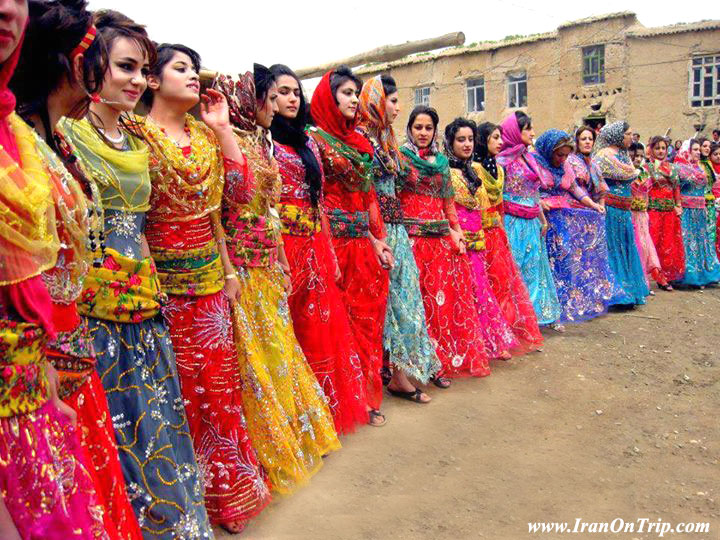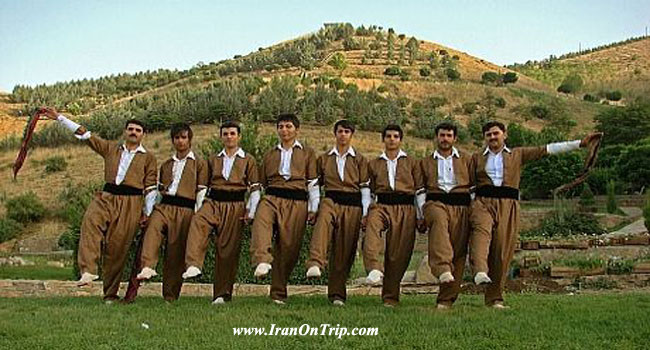Kurds Tribes in Iran

The Kurdish people of Iran occupy a vast area from the northernmost borderline of Azarbaijan to the hot plain of Khuzestan. Descendants of the Indo-European tribes that arrived in Iran in the first millennium BC, they speak an old Persian dialect and regard themselves as the descendants of the Medes. Kurds are to be found mainly in Iran, Iraq, and Turkey. In Iran, they consist of many tribes, of which the chief branches are:
The northern Kurds of Maku and northwestern Azarbaijan;The Mahabad Kurds, dwelling in the area between Lake Orumieh and the mountains of Kurdestan proper and the Khorassan;The Kurds of Sanandaj with subdivisions in Paveh, Saqqez, and the Iraqi border;The Kurds of Kermanshah, from the Zagros mountains to the Khuzestan plain. LUR TRIBESThey are probably the most intact tribes of Iran, retaining their robustness, virility, and tall stature. They are mostly cultivators and shepherds and occupy the high grounds of Lurestan, south of Kurdestan, and Kermanshah provinces.The Lursare thought to be a division of the ancient Kurds, both tribes being considered true descendants of the Medes. The Mamasani Lurs dwelling in western mountains of Fars form one of the most important clans.
Kurds; in the West & Northwest of Iran
The lack of an internationally recognised state of Kurdistan has not prevented the Kurds to consider themselves as a separate nation from the countries their territory is divided amongst. The just struggles of Kurdish nation in the last few decades for the recognition of their rights are well documented.
The oil reserves of Kurdistan region in Iran is in Kermanshah. Kurdistan has got a fertile land.

Although Kurdistan is a geographically homogenous land, politically it was first divided in 16th century amongst the two powers of the time, the Safavi and the Ottomans Empires. After the First World War, 400 years after its first division, Kurdistan was further divided by the Powers of the day (France and Britain) amongst the three newly established states of Turkey, Iraq and Syria. This was contrary to the agreement of Sever which recognised the formation of an independent state in Kurdistan. The division of Kurdistan into four parts was formalised in 1923 in the treaty of Luzan
Unfortunately, those countries that Kurdistan is divided amongst are reluctant to admit the presence of Kurds in the country (except in post Saddam Iraq). Only Iran Officially names a province as Kurdistan, which is a small portion of the Kurdish territory in Iran. In Turkey and Syria the presence of Kurds in the country was totally denied until recent years. In Iraq although the 1958 constitution recognised the Kurd and Arab to live side by side in the country, all their right was denied during the previous regime and they were subjected to genocide. After the first Gulf war of 1991, the Kurds in Iraq have entered a new era. The favourable international situation has resulted in a de-facto Kurdish government in Iraqi Kurdistan to be formed.
As it is explained above, although Kurdistan has been divided into four parts, Kurdish people during these long years have used every opportunity to express their dissatisfaction and struggled for their just rights. Contemporary Kurdish history is full of stories of Struggle, hope, disappointment, devastation of the land and sacrifice of their youth for a better life for the people in their ancestral land.
The Kurds of Iran since 19th century have had their fair share of the struggle for a just society in Iran. The uprising of Sheikh Ubaidullah and Hamza Aga Mangur (1880 – 1881 AC), the uprising of Ismail Simko (1920 AC) as well as few smaller regional uprising are examples of this struggle. Through out the contemporary history of Iran, Kurdistan has been a bastion for the progressive forces within Iran
After the establishment of the constitutional monarchy in 1906 AC, some of the demands of the nationalities of Iran, such as formation of regional assemblies were included in the constitution but have never been implemented.
Through out the 50 years rein of the Pahlavi dynasty ultra centralisation of power, militarisation of the region was the main government policy, and the struggle of Kurds for their rights continued. Only briefly during the Second World War, when Iran was occupied by the allies, the Kurds took this opportunity and formed their first structured political organisation (Komalai - J K) which later became the Kurdistan Democratic Party (KDP). Under the leadership of the KDP in February 1945 an autonomous republic in Iranian part of the Kurdistan was formed which lasted 11 month. The leadership of the republic, Qazi Mohammed and his comrades were executed in 1946 by Reza Shah’s government. Despite its short life, the Kurds still look at the Republic as a turning point in the history of Kurdish nation
Kurdish people along with other nationalities of Iran fully participated in the revolution of 1979, which resulted in overthrow of the monarchy and establishment of a republic. They thought this is an ideal opportunity to resolve all the problems with the new government and to put an end to decades of injustice. Despite plenty of good will from the Kurdish part and many months of negotiation, the newly established Islamic government imposed an unwanted war on the Kurdish people which resulted in many death and destruction. Now 29 years later, Kurdish people in Iran are not any closer to realising their dream of a democratic Iran that recognise the rights of all Iranian minorities.
Accurate population censuses are difficult to come by, as the consecutive governments in Iran distorted the published figures for their benefits. The total population of Kurds in Iran (Kurdistan regions and other major cities in Iran, except Khorasan region) are estimated to be more than 7 million, which is about 10% of the total population of Iran
The most majority of Kurds live in five provinces: Kurdistan Province(1.7 million), West Azerbaijan Province [more than 50% of the Province is Kurds; in figure it becomes more than 1.500.000, (Western part of the Province is Kurdish territory which is historically marked from the middle line of Urmiya Lake (meaning the Western part of the median course of the Lake)], Kermanshah province (2.2 million), Ilam Province [about 0.25 million (Northern part of the province)], Hamadan Province [about 0.4 million (western part of it)], and Luristan Province [about 0.2 million (Northern part of Luristan province)], all in the west of Iran. The total population of Kurds in the Kurdish dominated area in the Northwest and West of Iran estimates between 6 and 6.5 million
There are a considerable number of Kurds that estimates approximately 1.5 -2 million who is living in Major cities in Iran, such as: Tehran (about 7% of Tehran & Karaj’s population is Kurds), Varamin and Firoozkoh, Mazendaran Province (countryside of Cities such as: Daylaman, Sari, Kurdkoy and Noor), Gilan Province (Cities such as: Kalardasht, Roodbar, Manjil, Hashtpar and Assalem regions), and Kuhak region in the South of Qom.
There are also about 1.5 million Kurds who are living in Khorasan Province in North-east of Iran. This is descendents of the Kurds who were forcefully resettled there approximately 400 years ago by the Iranian government of the time.
The total population of Kurds in all over the state estimates between 8.5 to 9 million, which is about 12% of the total population of Iran.
.....
.....
.....

.jpg)



























